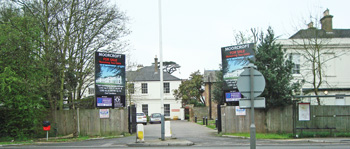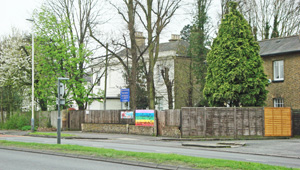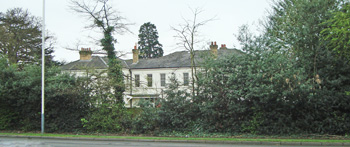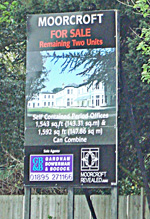Mental (Licensed House)
The oldest part of the 3-storey building dated back to Tudor times. The principal living rooms faced south, with the kitchens and the offices for the steward at the back of the building. The basement contained small cellars, in one of which ten priests were concealed for 4 days during the time of their persecution in the 16th century.
The asylum was run as a high-class establishment and, at first, both sexes were admitted. Patients were treated humanely with no coercion or mechanical restraints.
In 1831 the asylum was licensed for up to 30 lunatics, with Dr James Stilwell (proprietor-superintendent) and his son Dr James Stilwell, junior, as the licensees (by 1814 Dr James Stilwell, senior, already had a family of 8 children: of his 6 sons, 4 qualified as surgeons).
In 1837 there were 18 patients.
On 5th April 1839 the elder James Stilwell died aged 76 years. The family continued to run the asylum, with Dr William Stilwell as Resident Superintendent. Another son - Dr Arthur Stilwell - was appointed as Resident Medical Officer (by 1841 their 70-year-old mother, Ann Stilwell, had become a patient in the asylum).
By 1840 the number of patients had increased to 25 and, by 1843, to 30. It became necessary to extend the building, so another storey was added. In 1845 the asylum had 40 patients.
In 1848 Wood End House was purchased and the ladies were transferred there in order to make room for more male patients.
Only upper- and middle-class gentlemen were accepted as patients, with acute as well as quiet cases being admitted. Most were clergymen, barristers or farmers - and sometimes an earl or a baronet. Their customary dress consisted of a pair of nankeen breeches, a buff waistcoat, a stock and a blue frock coat with brass buttons. When out in the garden, a silk hat was worn.
On 6th June 1853 Arthur Stilwell died, and William Stilwell in 1857. Dr George James Stilwell took over the running of the asylum which, in 1861, had 61 resident staff and patients.
In 1867 George James Stilwell died suddenly aged only 34 years. The asylum was then licensed to Mrs E.S. Stilwell, Mr James Stilwell (1797-1870) and his cousin Dr Henry Stilwell, who became the Medical Superintendent.
In 1876 a wing was added to the western part of the house. It contained a large general sitting room, the attendants' quarters and a dispensary. In 1877 the asylum was licensed to Dr Henry Stilwell and Dr C.H. Hurford.
In 1881 the licensees were the Medical Superintendent, Dr Henry Stilwell (aged 45), and the manager, John Finnes Stilwell (aged 34), the son of Arthur Stilwell. A Resident Medical Officer was also employed.
The accommodation was very good, with the general domestic arrangements similar to those of a family mansion. There were a good number of attendants (who earned more than in most private asylums) and household servants. The average weekly charge for patients was from 4 to 6 guineas (£4.20 to £6.30). There were many Chancery patients; one paid as much as £1,300 a year, but had a separate house with his own attendants.
In 1891 an east wing was added to the main building. A detached house for the Medical Superintendent was built in the grounds. It was named The Lawn.
In 1898 there were 48 patients.
In the late 19th century a large wing was added at the southeast corner of the main building. The asylum was located on three sites, and consisted of Moorcroft House (for men) and Wood End House and Hayes Park (for women). The average numbers in residence were 39 men and 39 women.
The west wing of Moorcroft House was used to accommodate less tractable patients, while the east wing housed Mr and Mrs John Stilwell, who undertook the lay management of the asylum. A licence had been granted for 48 patients, including 8 ladies who were accommodated at Laurel Lodge (the former Medical Superintendent's house not far from the asylum) and the cottage. The house in the front garden - The Lawn - formerly occupied by Dr Henry Stilwell until his retirement was converted into a reception house for borderland cases or for a single certified patient. A separate villa on Moorcroft Farm was also used for patients, while single cases were accommodated in houses in the district further afield.
The grounds surrounding the mansion house totalled some 60 acres and included ornamental gardens, gavelled paths, a shrubbery, orchards and pasture lands, providing ample walks for those patients unable to take their exercise beyond the confines of the asylum. The flower garden was used for convalescent and quiet patients. There was a cricket ground - and also tennis courts, croquet lawns, and golf and bowling greens. A billiard room had been built away from the house. Church services were held every Sunday morning and evening in the large general sitting room in the west wing. Periodic fire drills were practised by the attendants under the supervision of one of the medical officers.
In 1908 the staff consisted of a Head Attendant, 16 attendants and a night attendant. Extra attendants were hired for suicidal cases. Two lady companions were hired to provide a humanizing effect on the patients.
Patients were admitted suffering mainly from general paralysis of the insane (G.P.I) (tertiary syphilis), delusional melancholia with refusal of food and suicidal tendencies, paranoia, alcoholism and dementia praecox (schizophrenia). Treatment was individually prescribed: modern drugs replaced the opium and tartarated antimony administered in former days. Hypnotics and sedatives were given sparingly, while anti-diphtheria serum was used experimentally to treat G.P.I. to some degree of success. Treatment by baths was used to subdue patients in a state of excitement, while electric baths were given to neurasthenic cases. Open air treatment was preferred for patients with acute delirious mania, exhaustion or suicidal tendencies, as opposed to keeping them in bed (as in public asylums). For patients who refused food, forcible feeding through a nasal tube was employed.
In 1909 Dr Henry Stilwell died at the age of 73. He had been the Physician-in-Charge of the asylum from 1867 to 1906. Dr Reginald J. Stilwell, who had married Henry's daughter Gertrude, continued to run the family business (Reginald died at the age of 80 on 5th June 1953).
After WW1 (1914-1918), new regulations in the running of asylums were introduced and these, together with the Depression, made the asylum less financially viable.
The asylum closed in 1947, thus bringing to an end the involvement of the Stilwell family in caring for psychiatric patients for over 150 years.
(N.B. The original spelling of the name - Stilwell - changed to Stillwell at some time in the 19th century. The former has been used throughout this text for consistency.)
Present status (April 2011)
In 1953 the Middlesex County Council purchased the property and the main building became a home for the elderly.
The Hillingdon Junior Training Centre for children and young adults with learning disabilities was built in the northwest corner of the grounds. It was renamed Moorcroft Special School in 1971. In 1998 the School moved to Bramble Close, near Hillingdon Hospital and is now known as Moorcroft School.
By 2002 the mansion was in poor condition, with some rooms unusable because of leaking roofs. It was sold to a property development company, which restored it and its associated buildings - the Coach House and The Lawns - and converted them into residences and offices. The School buildings were demolished and replaced by detached buildings containing 28 apartments. The site is now known as Moorcroft Park.
The surviving buildings are Grade II listed.

The entrance to the site on Harlington Road.

The white stuccoed lodge by the entrance.

Many extensions have been added to the original house (above and below).


The buildings have been converted into offices and residences.
(Author unstated) 1844 Reports from Commissioners. Parliamentary Papers, House of Commons and Command 18, 621.
(Author unstated) 1867 Obituary. George J. Stilwell, M.D. British Medical JournaL 2 (345), 118.
(Author unstated) 1882 Thirty-sixth Report of the Commissioners in Lunacy to the Lord Chancellor, Vol. 32. London, House of Commons.
(Author unstated) 1909 Obituary. Henry Stilwell, M.D. British Medical JournaL 1 (2521), 1034.
(Author unstated) 1953 Obituary. Reginald Stilwell. British Medical JournaL 1 (4824), 1396.
Cole RH 1908 A short account of Moorcroft, past and present. Journal of Mental Science 54, 181-186.
Forbes Winslow LS 1877 Handbook for Attendants on the Insane. London, Bailliere, Tindall & Cox.
Shelford L 1833 A Practical Treatise on the Law Concerning Lunatics, Idiots and Persons of Unsound Mind. London, S. Sweet and Stevens & Sons.
Wise S 2012 Inconvenient People: Lunacy, Liberty and the Mad-Doctors in Victorian England. London, Bodley Head.
http://historyofmedicineinireland.blogspot.co.uk
http://stilwellhistory.uk
http://studymore.org.uk
https://content.historicengland.org.uk
https://franciswright.wordpress.com
https://historic-hospitals.com
www.architecture.com
www.british-history.ac.uk
www.genealogy-specialists.com
www.hillingdon.gov.uk
Return to alphabetical list
Return to home page